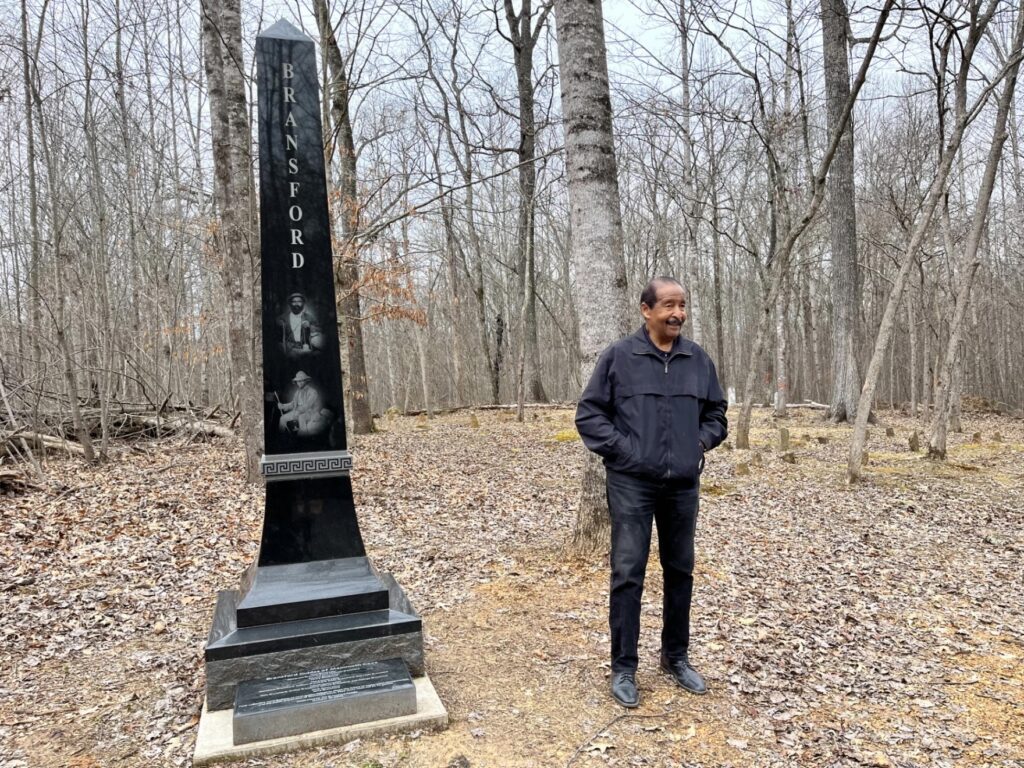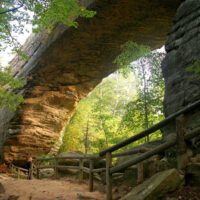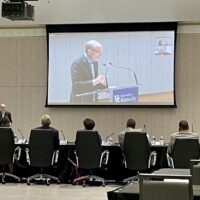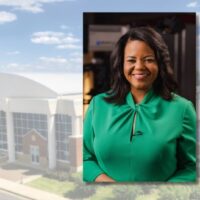An all-Black Civilian Conservation Corps group helped create cave tour routes, establish roads and carve out trails at Mammoth Cave in the 1930s.

That’s just one fact that was mentioned during a special ranger-led talk recently offered by Mammoth Cave National Park in honor of Black History Month.
Among the guests taking part in the talk was a man who knows the cave system well, as his ancestors were some of the first enslaved African American cave guides at the park.

Jerry Bransford is a fifth generation Bransford cave guide. His great-great-grandfathers — Materson Bransford and Nicholas Bransford — were both enslaved men and brought to Mammoth Cave from Nashville, Tennessee, to become two of the park’s first African American guides in 1838.
“They explored some of the routes and they learned to read and write. It was actually frowned upon or illegal for slaves to know how to read and write, but the record books say they only entertained and had guests that were the best educated from around the world through the cave,” Bransford said on the tour.
“We think that he (Materson) probably couldn’t write a letter, but he was well enough that he could at least write is name, Mat, and we just keep finding further out and deeper down into the cave.”
The Bransford Family history at Mammoth Cave is rich and enduring.
Materson’s son, Henry, became a cave guide in the 1860s. And two of Henry’s sons, Matt and Louis, were guides in the early 1900s.

Before Mammoth Cave became a national park, it was a settlement for more than 600 families in southern Kentucky. Enslaved guides were allowed to own land. The Bransford family land was on an area known as Flint Ridge.
“In the 1920s, my daddy used to run barefoot up and down those roads. The homestead was right at the bottom of the hill. He (Jerry’s dad) was born in 1914, and his daddy was born in 1876, and great grandpa born into slavery in 1849,” Bransford explained.
There was a school in the area, a church, the Bransford Summer Resort — which was a hotel for African Americans during times of segregation — and residential homes.
By the time the National Park Service started acquiring Mammoth Cave in 1939, the fourth generation of Bransford guides was giving tours of the cave system.
During the transition, residents had to leave their homes and under new cave operations, there were to be no more Black guides, ending more than 100 years of Bransford cave guides.
That was until Jerry Bransford came back, more than 60 years later.
Johnny Merideth, a supervisory park ranger for the division of interpretation at Mammoth Cave National Park, says when Jerry came to work at cave in the early 2000s, he already knew a little bit about his family ties to the cave system, but working there provided him with more details and an even closer connection to his ancestors.
“After years of being here, he’s gotten to go into the cave and see where his great great grandfather wrote his name in the 1800s and just various family members and their signatures in the cave,” Merideth said. “I know it’s been a very emotional and moving experience for him as I think it would for any of us.”
It’s emotional and moving because tracing ancestry can be challenging for African Americans, largely due to how records were kept during slavery.
Bransford not only knows his family ancestry, but he knows where those ancestors are located.

The Bransford Family Cemetery
The Bransford family cemetery is in Mammoth Cave National Park, sitting right off Flint Ridge Road, where the Bransford’s originally settled in the 1800s. Visitors walk about a quarter mile on a dirt path to get to it.
“After me coming to work here after retiring from my first job, I came down here and saw this. And I said well you know, this ought to be a place to celebrate instead of a place that makes you feel sad, you know? So, I had the idea of cleaning it up,” Bransford said.
In front of about 40 small stones that indicate a burial site, visitors will find signage with details of the Bransford Family history, a green park bench, and a large black stone with the name Bransford engraved on it with pictures of Materson and Nicholas.
Bransford told WKU Public Radio that being able to connect with his ancestors in this way is powerful.
While walking to the only proper headstones in the cemetery, where his great-grandfather, Henry, is buried, Bransford tells a story.
A legacy started by Materson
During the civil war, Materson and his wife, Parthena, had four children, and one day Parthena’s master told the couple that he was selling three of their children.
“Old folks say my grandma say, ‘Master, please don’t take my children, would you take me instead?’” Bransford said.
“He (Parthena’s master) says, ‘You get back to the cabin or I’ll whip you again.’ She lay in deep despair. Those children were tied to a rider and taken away from Mammoth Cave.”
After the children were taken, a Union soldier visited Materson after hearing what happened.
“He (union solider) says, ‘Matty it seems when you slaves lose your children, it doesn’t seem to bother you they say.’ Mat said, ‘Oh no captain, don’t you believe that. Slaves have feelings just like freed people. But what can I do about ol’ master selling my child?’”
The Union soldier then told Materson that the war would be over soon and that he could go back to Nashville a free man.
But Bransford said that Materson rejected the idea of leaving the area.
“He said, ‘Ol’ master stole my children. I’ve been in the cave all my life. The cave is in my blood.’”
Materson told the Union soldier that if he went back to Nashville, his children wouldn’t know where to find him, so he stayed at Mammoth Cave.
“We think that’s how come we stay here. This became our home. Never to leave, this became our permanent home,” Bransford said.
“A true American story”
After working at Mammoth Cave for almost 20 years and giving his family cemetery the care it needed, Jerry Bransford retired. He said the years spent at the cave were in honor of the Bransford’s who came before him.
“My ancestors left here and shortly after they left here, it was though they were never here. I just want to do what I can to recreate their story and tell you, tell America what happened. That’s what I’ve tried to do,” he said.

“I worked for someone else for a lot of years, but I’ve given my all working here at Mammoth Cave and trying in a decent way to share with America a true American story. That’s what I’ve tried to do.”
There hasn’t been another Bransford on the guide roles since Jerry Bransford retired in 2022.
But there’s a hope that this tradition will continue after Jerry Bransford, a legacy started by Materson in the 1800’s, when he decided to stay at Mammoth Cave for his children.
There’s a hope that a Bransford child will return to the cave and continue the work of their ancestors who will be waiting for them to come home.
This story is republished with permission from WKYU. Read the original.






